Phase 5: Maintain
During the lifetime of the partnership, our support team will work with customer to facilitate continuous improvement initiatives. You will be assigned a Service Delivery Manager. This individual is your single point of contact (SPOC) on a daily, weekly or monthly basis. Any issues, concerns or praises regarding our service can be addressed immediately with this individual. The Service Delivery Manager sets the meeting frequency with your team and reviews the reports generated for the service provided. The Service Delivery Manager advocates our Quality Assurance (QA) team, and all operational management engaged in a proactive effort to improve the customer service experience.
Back to Service Delivery Approach.



